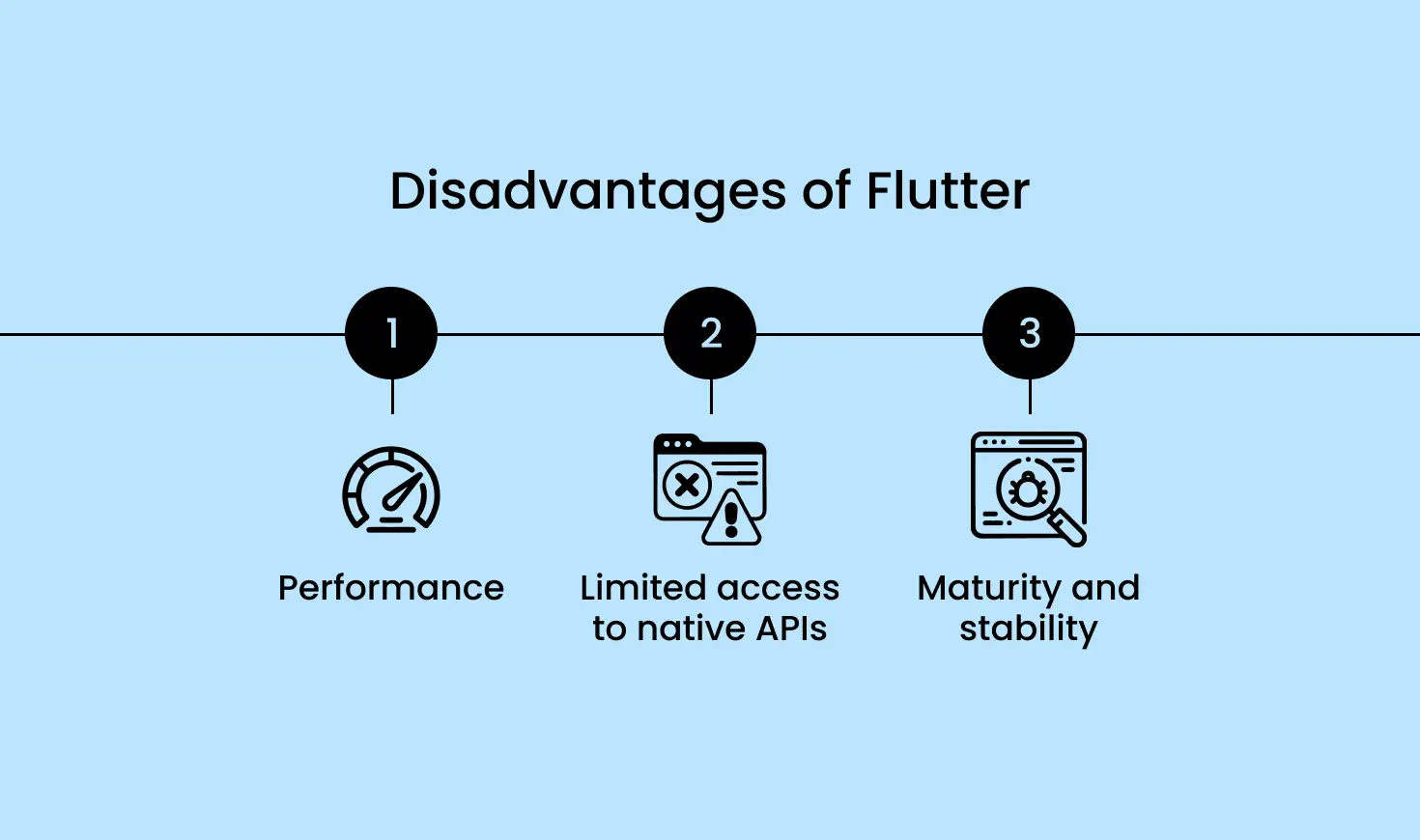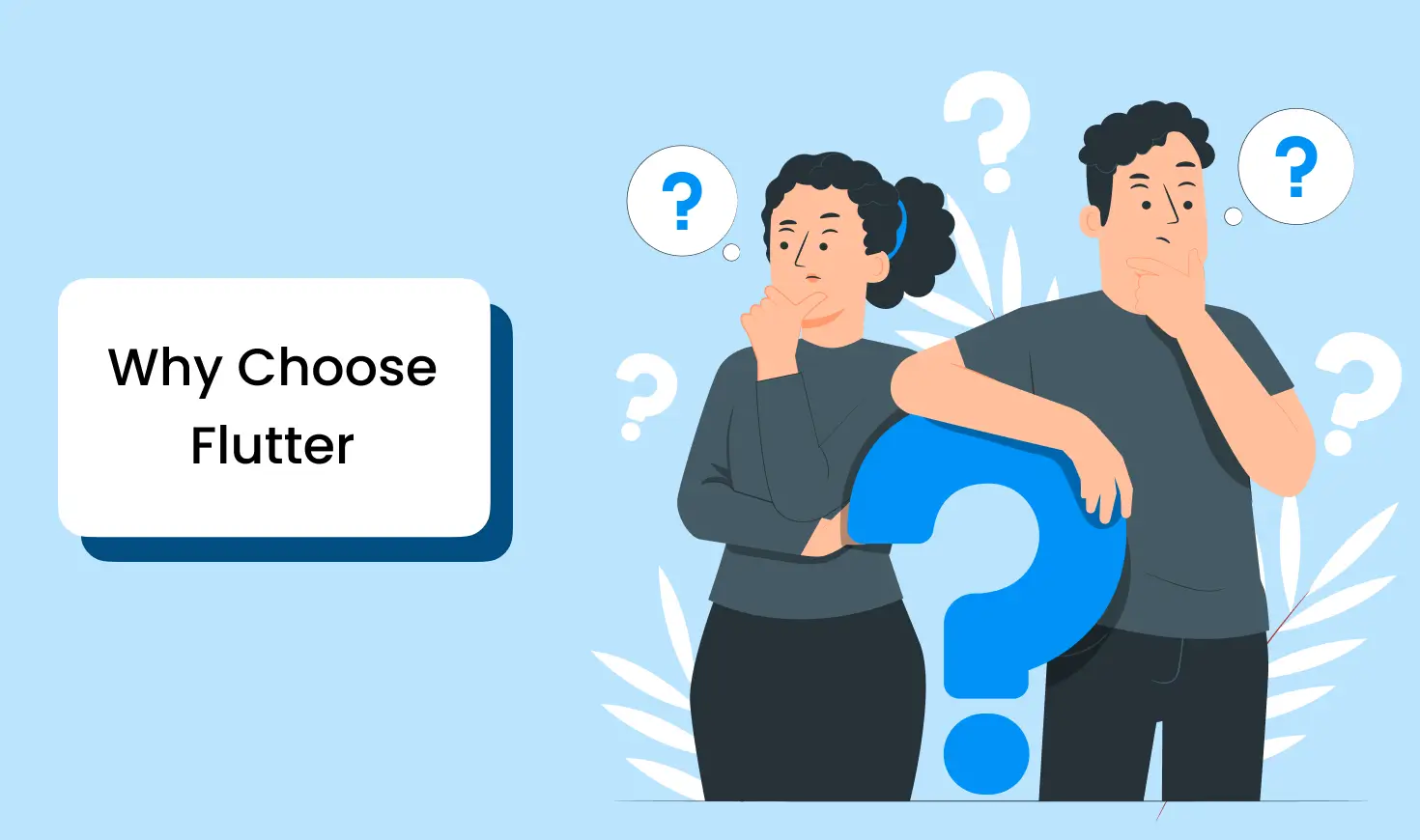Google's Flutter has taken the mobile app development world by storm as 46% software developers use it as a cross-platform mobile framework. With its ability to build stunning, high-performance apps for both iOS and Android from a single codebase, Flutter is revolutionizing the way developers create mobile experiences. But is it the right choice for your project? Let's learn more and discover why Flutter might be the game-changer you've been waiting for.
What is Flutter?
Flutter is a UI toolkit developed by Google that empowers developers to create native-compiled mobile apps for both iOS and Android platforms from a single codebase. This means you can write one set of code and deploy it to both operating systems, significantly reducing development time and effort. It uses the Dart programming language, which is relatively easy to learn for developers familiar with other object-oriented languages.
Advantages of Flutter

1. Cross-platform development
One of the most significant benefits of Flutter is its cross-platform capabilities. This means developers can create apps for both iOS and Android using a single codebase. This approach offers several advantages:
- Reduced development time and cost: By writing code once and deploying it to multiple platforms, developers can save time and resources.
- Consistent user experience: Flutter ensures a unified look and feel across both iOS and Android, providing a consistent experience for users.
- Simplified maintenance: Updates and bug fixes can be applied to both platforms simultaneously, reducing maintenance efforts.
2. Hot reload
Flutter's hot reload feature is a game-changer for developers. It allows them to see changes in their app instantly as they type code. This provides immediate feedback and significantly speeds up the development process.
- Faster iteration: Developers can experiment with different designs and features without having to restart the entire app.
- Improved debugging: Issues can be identified and fixed more quickly, as developers can see the impact of changes in real time.
- Enhanced productivity: Hot reload reduces the time it takes to bring ideas to life, improving overall developer productivity.
3. Rich UI and animations
Flutter offers a rich set of pre-built widgets and customization options, enabling developers to create beautiful and engaging user interfaces. These widgets can be easily combined and modified to match specific design requirements.
- Customizable UI: Developers can tailor the appearance and behavior of widgets to create unique and visually appealing interfaces.
- Animations and transitions: Flutter supports complex animations and transitions, adding dynamism and interactivity to apps.
- Material Design and Cupertino: Flutter adheres to Material Design guidelines for Android and Cupertino design principles for iOS, ensuring a native-like experience on both platforms.
4. Large and active community
Flutter has a growing and active community of developers. This means there are plenty of resources, tutorials, and support available for developers who are new to the framework or need help with specific tasks.
- Learning materials: A wide range of tutorials, documentation, and online courses are available to help developers learn Flutter.
- Community support: Developers can ask questions, share knowledge, and collaborate with others in online forums and communities.
- Third-party packages: A vast ecosystem of third-party packages and libraries exists, providing additional functionality and tools for Flutter development.
Disadvantages of Flutter

Performance
While Flutter has made significant strides in performance optimization, it can still experience some performance limitations compared to native apps, especially on older devices or for complex graphics-intensive tasks. This is primarily due to the overhead of the Flutter engine and the need to render UI elements using Skia, a 2D graphics library.
- JIT compilation: Flutter uses Just-In-Time (JIT) compilation, which can introduce some performance overhead compared to Ahead-of-Time (AOT) compilation used in native apps.
- Graphics rendering: Skia, while a powerful graphics library, can introduce performance overhead compared to native graphics APIs.
- Device limitations: Older devices with lower-end hardware may struggle to handle Flutter apps with complex graphics or animations.
Limited access to native APIs
Flutter provides a rich set of pre-built widgets and APIs, but its access to native APIs is not as extensive as native development. This can limit its flexibility for certain features, especially those that require deep integration with the device's hardware or operating system.
- Platform-specific features: If your app needs to leverage platform-specific features or APIs that are not directly exposed by Flutter, you may need to write platform-specific code or use third-party plugins.
- Performance-critical tasks: For tasks that require low-level access to the device's hardware or operating system, native development may be more suitable.
Maturity and stability
As a relatively new framework, Flutter may not be as mature or stable as native development tools. This means there is a higher risk of encountering bugs, compatibility issues, or breaking changes.
- Evolving ecosystem: Flutter's ecosystem is constantly evolving, and new features or changes may introduce compatibility issues.
- Limited testing: As a newer framework, Flutter may have less extensive testing coverage compared to more established native development tools.
- Potential for breaking changes: Updates to Flutter may introduce breaking changes that require code modifications.
When to Choose Flutter

Flutter is an excellent choice for developers seeking to create next-gen mobile apps that benefit businesses. Here’s a runthrough of some situations where you can opt for flutter for seamless development, testing, and deployment.
Cross-platform apps with consistent UI
If you're looking to create an app that targets both iOS and Android and prioritizes a consistent user experience across both platforms, Flutter is an excellent choice. Its ability to develop apps using a single codebase ensures a unified look and feel, saving you time and effort.
Rapid development and prototyping
Flutter's hot reload feature makes it an ideal tool for rapid development and prototyping. This feature allows you to see changes to your app instantly as you type code, enabling you to quickly iterate on your design and experiment with different features. This can significantly accelerate the development process and help you refine your app's concept before investing heavily in development.
Complex animations and UI
If your app requires complex animations and visually appealing user interfaces, Flutter's rich UI and animation capabilities make it a strong contender. Flutter provides a wide range of pre-built widgets and customization options, allowing you to create stunning and interactive designs.
Small to medium-sized projects
Flutter is particularly well-suited for small to medium-sized projects. Its ease of use and rapid development capabilities make it an efficient choice for projects with manageable complexity. However, for larger, more complex projects with extensive native integrations or performance-critical requirements, native development may be a better option.
Some Successful Flutter Apps That You Would’ve Used
Flutter has been adopted by many well-known companies to build their mobile applications. Here are a few examples of successful Flutter apps that you may have used:
- Google Ads: Google Ads, one of the most popular advertising platforms, is built with Flutter. The app offers a seamless experience for managing campaigns, tracking performance, and getting expert assistance.
- eBay Motors: eBay Motors, the official app for buying and selling cars on eBay, leverages Flutter to provide a smooth and intuitive user experience.
- Etsy: Etsy, an online marketplace for handmade and vintage goods, uses Flutter to accelerate its app development and offer a better experience for sellers.
- SpaceX Go: SpaceX Go, a simple and effective app for tracking SpaceX launches, is built with Flutter. The app provides real-time updates and information about upcoming missions.
- BMW: BMW has developed a Flutter-based app called My BMW, which allows users to control their vehicles remotely, check vehicle status, and more.
- Google Pay: Google Pay, a popular mobile payment app, has been redesigned using Flutter to improve its performance and user experience across both iOS and Android platforms.
These are just a few examples of the many successful Flutter apps that have been developed. Flutter's ability to create high-performance, cross-platform apps has made it a popular choice for businesses of all sizes
Conclusion
Flutter is a powerful and flexible framework that can be a great choice for app development, especially for cross-platform projects. However, it's important to consider its limitations and evaluate whether it's the right fit for your specific needs. By carefully weighing the advantages and disadvantages, you can make an informed decision about whether Flutter is the right tool for your app development project.
If you need help with flutter app development, then PragetX can help you from designing the wireframes to developing and deploying your app.
Contact us for getting a custom quote.
Some FAQs Answered
1. Is Flutter suitable for large-scale enterprise apps?
While Flutter has been successfully used for large-scale enterprise apps, it's essential to consider your specific project requirements. For projects with complex native integrations or performance-critical tasks, native development might be more suitable. However, Flutter's growing maturity and performance improvements make it a viable option for many enterprise-level apps.
2. How does Flutter compare to React Native in terms of performance?
Both Flutter and React Native offer excellent performance, but they approach it differently. Flutter compiles directly to native code, providing a performance boost. React Native relies on a JavaScript bridge for communication, which can introduce some overhead. In general, Flutter tends to have slightly better performance, especially for complex animations and graphics-intensive tasks.
3. Can I use Flutter to develop web apps?
While Flutter was primarily designed for mobile app development, Google has introduced Flutter for the web, allowing you to use the same codebase to create web applications. This can be a great way to achieve consistency across different platforms and reduce development time.
4. How does Flutter's ecosystem compare to other frameworks?
Flutter has a rapidly growing ecosystem with a vast array of third-party packages, libraries, and tools. This makes it easier for developers to find solutions for common tasks and extend the framework's capabilities. While the ecosystem may not be as mature as some other frameworks, it's constantly expanding and improving.






